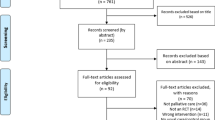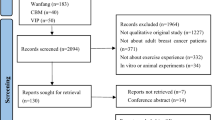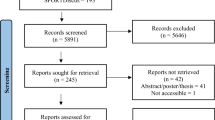Abstract
Purpose
Exercise has been shown to improve the health and well-being of people who have survived cancer. Yet, less than 40% of cancer survivors in Australia meet the recommended 150 min of moderate-intensity physical activity per week. Our objective was to systematically review the literature regarding barriers, facilitators and preferences for exercise for survivors of cancer.
Method
MEDLINE, EMBASE, CINAHL, PsycINFO and Scopus were searched for qualitative and quantitative articles addressing barriers, facilitators and preferences for exercise in cancer survivors. Quality assessment was performed by two independent reviewers using the Mixed Methods Appraisal Tool. Thomas and Harden’s method of thematic synthesis was used to amalgamate qualitative data while descriptive statistics were used to collate quantitative data.
Results
Nineteen studies were included (9 qualitative and 10 quantitative). Persisting treatment-related side effects was the most commonly reported barrier to initiating or maintaining exercise, followed by lack of time and fatigue. The most common facilitators of exercise were gaining a feeling of control over their health as well as managing emotions and mental well-being, while the preferred method of exercise was walking. We also identified a lack of useful information provided to survivors regarding exercise.
Conclusion
Treatment-related side effects, lack of time and fatigue were key barriers to exercise for survivors of varied cancer types. Insufficient patient education may contribute to the belief that exercise is not helpful when experiencing side effects of treatment, including fatigue. Identifying barriers and facilitators leads to improved support and education from health professionals which is required to provide safe and effective exercise recommendations for survivors.


Similar content being viewed by others
References
Torre LA, Bray F, Siegel RL, Ferlay J, Lortet-Tieulent J, Jemal A (2015) Global cancer statistics, 2012. CA Cancer J Clin 65(2):87–108. https://doi.org/10.3322/caac.21262
Parry C, Kent EE, Mariotto AB, Alfano CM, Rowland JH (2011) Cancer survivors: a booming population. Cancer Epidemiol Biomarkers Prev 20(10):1996–2005. https://doi.org/10.1158/1055-9965.EPI-11-0729
Fallon MT (2013) Neuropathic pain in cancer. Br J Anaesth 111(1):105–111. https://doi.org/10.1093/bja/aet208
McDougall GJ Jr, Oliver JS, Scogin F (2014) Memory and cancer: a review of the literature. Arch Psychiatr Nurs 28(3):180–186. https://doi.org/10.1016/j.apnu.2013.12.005
Pachman DR, Barton DL, Swetz KM, Loprinzi CL (2012) Troublesome symptoms in cancer survivors: fatigue, insomnia, neuropathy, and pain. J Clin Oncol 30(30):3687–3696. https://doi.org/10.1200/JCO.2012.41.7238
Barreto R, Waning DL, Gao H, Liu Y, Zimmers TA, Bonetto A (2016) Chemotherapy-related cachexia is associated with mitochondrial depletion and the activation of ERK1/2 and p38 MAPKs. Oncotarget 7(28):43442–43460. 10.18632/oncotarget.9779
Padilha CS, Marinello PC, Galvao DA, Newton RU, Borges FH, Frajacomo F, Deminice R (2017) Evaluation of resistance training to improve muscular strength and body composition in cancer patients undergoing neoadjuvant and adjuvant therapy: a meta-analysis. J Cancer Surviv 11(3):339–349. https://doi.org/10.1007/s11764-016-0592-x
Fong DY, Ho JW, Hui BP, Lee AM, Macfarlane DJ, Leung SS, Cerin E, Chan WY, Leung IP, Lam SH, Taylor AJ, Cheng KK (2012) Physical activity for cancer survivors: meta-analysis of randomised controlled trials. BMJ (Clin Res Ed) 344(jan30 5):e70. https://doi.org/10.1136/bmj.e70
Borch KB, Braaten T, Lund E, Weiderpass E (2015) Physical activity before and after breast cancer diagnosis and survival - the Norwegian women and cancer cohort study. BMC Cancer 15(1):967. https://doi.org/10.1186/s12885-015-1971-9
Ballard-Barbash R, Friedenreich CM, Courneya KS, Siddiqi SM, McTiernan A, Alfano CM (2012) Physical activity, biomarkers, and disease outcomes in cancer survivors: a systematic review. J Natl Cancer Inst 104(11):815–840. https://doi.org/10.1093/jnci/djs207
Zhou Y, Chlebowski R, LaMonte MJ, Bea JW, Qi L, Wallace R, Lavasani S, Walsh BW, Anderson G, Vitolins M, Sarto G, Irwin ML (2014) Body mass index, physical activity, and mortality in women diagnosed with ovarian cancer: results from the Women’s Health Initiative. Gynecol Oncol 133(1):4–10. https://doi.org/10.1016/j.ygyno.2014.01.033
Wang A, Qin F, Hedlin H, Desai M, Chlebowski R, Gomez S, Eaton CB, Johnson KC, Qi L, Wactawski-Wende J, Womack C, Wakelee HA, Stefanick ML (2016) Physical activity and sedentary behavior in relation to lung cancer incidence and mortality in older women: the Women’s Health Initiative. Int J Cancer 139(10):2178–2192. https://doi.org/10.1002/ijc.30281
Li T, Wei S, Shi Y, Pang S, Qin Q, Yin J, Deng Y, Chen Q, Wei S, Nie S, Liu L (2016) The dose-response effect of physical activity on cancer mortality: findings from 71 prospective cohort studies. Br J Sports Med 50(6):339–345. https://doi.org/10.1136/bjsports-2015-094927
Cormie P, Zopf EM, Zhang X, Schmitz KH (2017) The impact of exercise on cancer mortality, recurrence, and treatment-related adverse effects. Epidemiol Rev 39(1):71–92. https://doi.org/10.1093/epirev/mxx007
Schmitz KH, Courneya KS, Matthews C, Demark-Wahnefried W, Galvao DA, Pinto BM, Irwin ML, Wolin KY, Segal RJ, Lucia A, Schneider CM, von Gruenigen VE, Schwartz AL, American College of Sports M (2010) American College of Sports Medicine roundtable on exercise guidelines for cancer survivors. Med Sci Sports Exerc 42(7):1409–1426. https://doi.org/10.1249/MSS.0b013e3181e0c112
Tarasenko Y, Chen C, Schoenberg N (2017) Self-reported physical activity levels of older cancer survivors: results from the 2014 National Health Interview Survey. J Am Geriatr Soc 65(2):e39–e44. https://doi.org/10.1111/jgs.14589
Irwin ML, McTiernan A, Bernstein L, Gilliland FD, Baumgartner R, Baumgartner K, Ballard-Barbash R (2004) Physical activity levels among breast cancer survivors. Med Sci Sports Exerc 36(9):1484–1491
Cro mbie IK, Irvine L, Williams B, McGinnis AR, Slane PW, Alder EM, McMurdo ME (2004) Why older people do not participate in leisure time physical activity: a survey of activity levels, beliefs and deterrents. Age Ageing 33(3):287–292. https://doi.org/10.1093/ageing/afh089
Pluye P, Robert E, Cargo M, Bartlett G, O’Cathain A, Griffiths F, Boardman F, Gagnon MP, Rousseau MC (2011) Proposal: a mixed methods appraisal tool for systematic mixed studies reviews. Department of Family Medicine, McGill University, Montreal retrieved on 5 March 2016 from http://mixedmethodsappraisaltoolpublic.pbworks.com
Pluye P, Gagnon MP, Griffiths F, Johnson-Lafleur J (2009) A scoring system for appraising mixed methods research, and concomitantly appraising qualitative, quantitative and mixed methods primary studies in mixed studies reviews. Int J Nurs Stud 46(4):529–546. https://doi.org/10.1016/j.ijnurstu.2009.01.009
Pace R, Pluye P, Bartlett G, Macaulay AC, Salsberg J, Jagosh J, Seller R (2012) Testing the reliability and efficiency of the pilot mixed methods appraisal tool (MMAT) for systematic mixed studies review. Int J Nurs Stud 49(1):47–53. https://doi.org/10.1016/j.ijnurstu.2011.07.002
Massey D, Chaboyer W, Anderson V (2017) What factors influence ward nurses’ recognition of and response to patient deterioration? An integrative review of the literature. Nursing Open 4(1):6–23. https://doi.org/10.1002/nop2.53
Mey A, Plummer D, Dukie S, Rogers GD, O'Sullivan M, Domberelli A (2017) Motivations and barriers to treatment uptake and adherence among people living with HIV in Australia: a mixed-methods systematic review. AIDS Behav 21(2):352–385. https://doi.org/10.1007/s10461-016-1598-0
Thomas J, Harden A (2008) Methods for the thematic synthesis of qualitative research in systematic reviews. BMC Med Res Methodol 8(1):45. https://doi.org/10.1186/1471-2288-8-45
McHugh ML (2012) Interrater reliability: the kappa statistic. Biochem Med (Zagreb) 22(3):276–282
Anderson AS, Caswell S, Wells M, Steele RJ, Macaskill S (2010) "It makes you feel so full of life" LiveWell, a feasibility study of a personalised lifestyle programme for colorectal cancer survivors. Support Care Cancer: Off J Multinatl Assoc Support Care Cancer 18(4):409–415. https://doi.org/10.1007/s00520-009-0677-4
Bulmer SM, Howell J, Ackerman L, Fedric R (2012) Women's perceived benefits of exercise during and after breast cancer treatment. Women Health 52(8):771–787. https://doi.org/10.1080/03630242.2012.725707
Cormie P, Turner B, Kaczmarek E, Drake D, Chambers SK (2015) A qualitative exploration of the experience of men with prostate cancer involved in supervised exercise programs. Oncol Nurs Forum 42(1):24–32. https://doi.org/10.1188/15.ONF.24-32
Craike MJ, Livingston PM, Botti M (2011) An exploratory study of the factors that influence physical activity for prostate cancer survivors. Support Care Cancer 19(7):1019–1028. https://doi.org/10.1007/s00520-010-0929-3
Hefferon K, Murphy H, McLeod J, Mutrie N, Campbell A (2013) Understanding barriers to exercise implementation 5-year post-breast cancer diagnosis: a large-scale qualitative study. Health Educ Res 28(5):843–856. https://doi.org/10.1093/her/cyt083
Lim JW, Gonzalez P, Wang-Letzkus MF, Baik O, Ashing-Giwa KT (2013) Health behavior changes following breast cancer treatment: a qualitative comparison among Chinese American, Korean American, and Mexican American survivors. J Health Care Poor Underserved 24(2):599–618. https://doi.org/10.1353/hpu.2013.0094
Martin E, Bulsara C, Battaglini C, Hands B, Naumann FL (2015) Breast and prostate cancer survivor responses to group exercise and supportive group psychotherapy. J Psychosoc Oncol 33(6):620–634. https://doi.org/10.1080/07347332.2015.1082166
Midtgaard J, Rossell K, Christensen JF, Uth J, Adamsen L, Rorth M (2012) Demonstration and manifestation of self-determination and illness resistance--a qualitative study of long-term maintenance of physical activity in posttreatment cancer survivors. Support Care Cancer 20(9):1999–2008. https://doi.org/10.1007/s00520-011-1304-8
Rabin C, Simpson N, Morrow K, Pinto B (2011) Behavioral and psychosocial program needs of young adult cancer survivors. Qual Health Res 21(6):796–806. https://doi.org/10.1177/1049732310380060
Wright-St Clair VA, Malcolm W, Keogh JW (2014) The lived experience of physically active older prostate cancer survivors on androgen deprivation therapy. Aging Male 17(1):57–62. https://doi.org/10.3109/13685538.2013.818113
Arroyave WD, Clipp EC, Miller PE, Jones LW, Ward DS, Bonner MJ, Rosoff PM, Snyder DC, Demark-Wahnefried W (2008) Childhood cancer survivors' perceived barriers to improving exercise and dietary behaviors. Oncol Nurs Forum 35(1):121–130. https://doi.org/10.1188/08.ONF.121-130
Charlier C, Van Hoof E, Pauwels E, Lechner L, Spittaels H, De Bourdeaudhuij I (2013) The contribution of general and cancer-related variables in explaining physical activity in a breast cancer population 3 weeks to 6 months post-treatment. Psychooncology 22(1):203–211. https://doi.org/10.1002/pon.2079
Coups EJ, Park BJ, Feinstein MB, Steingart RM, Egleston BL, Wilson DJ, Ostroff JS (2009) Correlates of physical activity among lung cancer survivors. Psychooncology 18(4):395–404. https://doi.org/10.1002/pon.1520
Courneya KS, Friedenreich CM, Quinney HA, Fields AL, Jones LW, Vallance JK, Fairey AS (2005) A longitudinal study of exercise barriers in colorectal cancer survivors participating in a randomized controlled trial. Annals of behavioral medicine: a publication of the society of. Behav Med 29(2):147–153. https://doi.org/10.1207/s15324796abm2902_9
Gho SA, Munro BJ, Jones SC, Steele JR (2014) Exercise bra discomfort is associated with insufficient exercise levels among Australian women treated for breast cancer. Support Care Cancer 22(3):721–729. https://doi.org/10.1007/s00520-013-2027-9
Gjerset GM, Fossa SD, Courneya KS, Skovlund E, Jacobsen AB, Thorsen L (2011) Interest and preferences for exercise counselling and programming among Norwegian cancer survivors. Eur J Cancer Care (Engl) 20(1):96–105. https://doi.org/10.1111/j.1365-2354.2009.01161.x
Kang DW, Chung JY, Lee MK, Lee J, Park JH, Kim DI, Jones LW, Ahn JB, Kim NK, Jeon JY (2014) Exercise barriers in Korean colorectal cancer patients. Asian Pac J Cancer Prev: APJCP 15(18):7539–754543
Karvinen KH, Courneya KS, Venner P, North S (2007) Exercise programming and counseling preferences in bladder cancer survivors: a population-based study. J Cancer Surviv 1(1):27–34. https://doi.org/10.1007/s11764-007-0010-5
Ottenbacher AJ, Day RS, Taylor WC, Sharma SV, Sloane R, Snyder DC, Kraus WE, Demark-Wahnefried W (2011) Exercise among breast and prostate cancer survivors-what are their barriers? J Cancer Surviv 5(4):413–419
Justine M, Azizan A, Hassan V, Salleh Z, Manaf H (2013) Barriers to participation in physical activity and exercise among middle-aged and elderly individuals. Singap Med J 54(10):581–586
Jacobs LA, Shulman LN (2017) Follow-up care of cancer survivors: challenges and solutions. Lancet Oncol 18(1):e19–e29. https://doi.org/10.1016/S1470-2045(16)30386-2
Bower JE, Ganz PA, Desmond KA, Rowland JH, Meyerowitz BE, Belin TR (2000) Fatigue in breast cancer survivors: occurrence, correlates, and impact on quality of life. J Clin Oncol Off J Am Soc Clin Oncol 18(4):743–753. https://doi.org/10.1200/JCO.2000.18.4.743
Goldstein D, Bennett BK, Webber K, Boyle F, de Souza PL, Wilcken NR, Scott EM, Toppler R, Murie P, O'Malley L, McCourt J, Friedlander M, Hickie IB, Lloyd AR (2012) Cancer-related fatigue in women with breast cancer: outcomes of a 5-year prospective cohort study. J Clin Oncol Off J Am Soc Clin Oncol 30(15):1805–1812. https://doi.org/10.1200/JCO.2011.34.6148
Sandler CX, Goldstein D, Horsfield S, Bennett BK, Friedlander M, Bastick PA, Lewis CR, Segelov E, Boyle FM, Chin MTM, Webber K, Barry BK, Lloyd AR (2017) Randomized evaluation of cognitive-behavioral therapy and graded exercise therapy for post-cancer fatigue. J Pain Symptom Manag. https://doi.org/10.1016/j.jpainsymman.2017.03.015
Brown JC, Huedo-Medina TB, Pescatello LS, Pescatello SM, Ferrer RA, Johnson BT (2011) Efficacy of exercise interventions in modulating cancer-related fatigue among adult cancer survivors: a meta-analysis. Cancer Epidemiol Biomark Prev: Publ Am Assoc Cancer Res Cosponsored Am Soc Prev Oncol 20(1):123–133. https://doi.org/10.1158/1055-9965.EPI-10-0988
SFitzgerald B (2007) Review: regular exercise improves quality of life and physical fitness in women with breast cancer. Evidence-based Nurs 10(1):12. https://doi.org/10.1136/ebn.10.1.12
McNeely ML, Campbell KL, Rowe BH, Klassen TP, Mackey JR, Courneya KS (2006) Effects of exercise on breast cancer patients and survivors: a systematic review and meta-analysis. CMAJ: Can Med Assoc J: J Assoc Medic Can 175(1):34–41. https://doi.org/10.1503/cmaj.051073
Rogers LQ, Courneya KS, Anton PM, Verhulst S, Vicari SK, Robbs RS, McAuley E (2016) Effects of a multicomponent physical activity behavior change intervention on fatigue, anxiety, and depressive symptomatology in breast cancer survivors: randomized trial. Psycho-oncol. https://doi.org/10.1002/pon.4254
Gothe NP, Kendall BJ (2016) Barriers, motivations, and preferences for physical activity among female African American older adults. Gerontol geriatr Med 2:2333721416677399. https://doi.org/10.1177/2333721416677399
Perry RA, Daniels LA, Bell L, Magarey AM (2017) Facilitators and barriers to the achievement of healthy lifestyle goals: qualitative findings from Australian parents enrolled in the PEACH child weight management program. J Nutr Educ Behav 49(1):43–52 e41. https://doi.org/10.1016/j.jneb.2016.08.018
Bourke L, Homer KE, Thaha MA, Steed L, Rosario DJ, Robb KA, Saxton JM, Taylor SJ (2013) Interventions for promoting habitual exercise in people living with and beyond cancer. Cochrane Database Syst Rev 9(9):CD010192. https://doi.org/10.1002/14651858.CD010192.pub2
Matson-Koffman DM, Brownstein JN, Neiner JA, Greaney ML (2005) A site-specific literature review of policy and environmental interventions that promote physical activity and nutrition for cardiovascular health: what works? Am J Health Promot: AJHP 19(3):167–193
Ries AV, Yan AF, Voorhees CC (2011) The neighborhood recreational environment and physical activity among urban youth: an examination of public and private recreational facilities. J Community Health 36(4):640–649. https://doi.org/10.1007/s10900-010-9355-1
Hansen D, Dendale P, van Loon LJ, Meeusen R (2010) The impact of training modalities on the clinical benefits of exercise intervention in patients with cardiovascular disease risk or type 2 diabetes mellitus. Sports Med (Auckland, NZ) 40(11):921–940. https://doi.org/10.2165/11535930-000000000-00000
Toohey K, Pumpa KL, Arnolda L, Cooke J, Yip D, Craft PS, Semple S (2016) A pilot study examining the effects of low-volume high-intensity interval training and continuous low to moderate intensity training on quality of life, functional capacity and cardiovascular risk factors in cancer survivors. PeerJ 4:e2613. https://doi.org/10.7717/peerj.2613
Schmitt J, Lindner N, Reuss-Borst M, Holmberg HC, Sperlich B (2016) A 3-week multimodal intervention involving high-intensity interval training in female cancer survivors: a randomized controlled trial. Physiological Rep 4(3). 10.14814/phy2.12693
Stonerock GL, Blumenthal JA (2017) Role of counseling to promote adherence in healthy lifestyle medicine: strategies to improve exercise adherence and enhance physical activity. Progress Cardiovasc Dis 59(5):455–462. https://doi.org/10.1016/j.pcad.2016.09.003
Smith L, Croker H, Fisher A, Williams K, Wardle J, Beeken RJ (2017) Cancer survivors' attitudes towards and knowledge of physical activity, sources of information, and barriers and facilitators of engagement: a qualitative study. Eur J Cancer Care. https://doi.org/10.1111/ecc.12641
Bluethmann SM, Vernon SW, Gabriel KP, Murphy CC, Bartholomew LK (2015) Taking the next step: a systematic review and meta-analysis of physical activity and behavior change interventions in recent posttreatment breast cancer survivors. Breast Cancer Res Treat 149(2):331–342. https://doi.org/10.1007/s10549-014-3255-5
Eakin EG, Lawler SP, Winkler EA, Hayes SC (2012) A randomized trial of a telephone-delivered exercise intervention for non-urban dwelling women newly diagnosed with breast cancer: exercise for health. Annals of behavioral medicine: a publication of the society of. Behav Med 43(2):229–238. https://doi.org/10.1007/s12160-011-9324-7
Liss MA, Schenk JM, Faino AV, Newcomb LF, Boyer H, Brooks JD, Carroll PR, Dash A, Fabrizio MD, Gleave ME, Nelson PS, Neuhouser ML, Wei JT, Zheng Y, Wright JL, Lin DW, Thompson IM (2016) A diagnosis of prostate cancer and pursuit of active surveillance is not followed by weight loss: potential for a teachable moment. Prostate Cancer Prostatic Dis 19(4):390–394. https://doi.org/10.1038/pcan.2016.28
Alfano CM, Day JM, Katz ML, Herndon JE 2nd, Bittoni MA, Oliveri JM, Donohue K, Paskett ED (2009) Exercise and dietary change after diagnosis and cancer-related symptoms in long-term survivors of breast cancer: CALGB 79804. Psycho-oncol 18(2):128–133. https://doi.org/10.1002/pon.1378
Lim JW, Gonzalez P, Wang-Letzkus MF, Baik O, Ashing-Giwa KT Health behavior changes following breast cancer treatment: a qualitative comparison among Chinese American, Korean American, and Mexican American survivors. J Health Care Poor Underserved 24(2):599–618
Strasser B, Steindorf K, Wiskemann J (2011p) Ulrich CM (2013) impact of resistance training in cancer survivors: a meta-analysis. Med Sci Sports Exerc 45(11):2080–2090. https://doi.org/10.1249/MSS.0b013e31829a3b63
Hardee JP, Porter RR, Sui X, Archer E, Lee IM, Lavie CJ, Blair SN (2014) The effect of resistance exercise on all-cause mortality in cancer survivors. Mayo Clinic proceedings 89(8):1108–1115 1108p. https://doi.org/10.1016/j.mayocp.2014.03.018
Mishra SI, Scherer RW, Geigle PM, Berlanstein DR, Topaloglu O, Gotay CC, Snyder C (2012) Exercise interventions on health-related quality of life for cancer survivors. Cochrane Database Syst Rev 8(8):CD007566. https://doi.org/10.1002/14651858.CD007566.pub2
Mutrie N, Campbell AM, Whyte F, McConnachie A, Emslie C, Lee L, Kearney N, Walker A, Ritchie D (2007) Benefits of supervised group exercise programme for women being treated for early stage breast cancer: pragmatic randomised controlled trial. BMJ (Clin Res ed) 334(7592):517. https://doi.org/10.1136/bmj.39094.648553.AE
Souto RQ, Khanassov V, Hong QN, Bush PL, Vedel I, Pluye P (2015) Systematic mixed studies reviews: updating results on the reliability and efficiency of the mixed methods appraisal tool. Int J Nurs Stud 52(1):500–501. https://doi.org/10.1016/j.ijnurstu.2014.08.010
Sandelowski M, Voils CI, Knafl G (2009) On Quantitizing. J Mixed Methods Res 3(3):208–222. https://doi.org/10.1177/1558689809334210
Sandelowski M (2001) Real qualitative researchers do not count: the use of numbers in qualitative research. Res Nurs Health 24(3):230–240
O'Cathain A, Thomas KJ, Drabble SJ, Rudolph A, Goode J, Hewison J (2014) Maximising the value of combining qualitative research and randomised controlled trials in health research: the QUAlitative research in trials (QUART) study--a mixed methods study. Health Rechnol Assess (Winchester, England) 18(38):1–197, v-vi. https://doi.org/10.3310/hta18380
Funding
Claire Wakefield is supported by a Career Development Fellowship from the National Health and Medical Research Council (NHMRC) of Australia (APP1067501). The Behavioural Sciences Unit is proudly supported by the Kids with Cancer Foundation.
Author information
Authors and Affiliations
Corresponding author
Ethics declarations
Conflict of interest
The authors declare that they have no conflict of interest.
Rights and permissions
About this article
Cite this article
Clifford, B.K., Mizrahi, D., Sandler, C.X. et al. Barriers and facilitators of exercise experienced by cancer survivors: a mixed methods systematic review. Support Care Cancer 26, 685–700 (2018). https://doi.org/10.1007/s00520-017-3964-5
Received:
Accepted:
Published:
Issue Date:
DOI: https://doi.org/10.1007/s00520-017-3964-5




